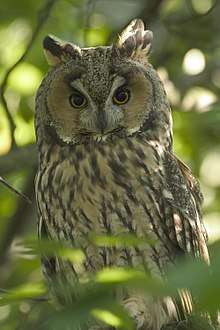Asio
Asio is a genus of typical owls, or true owls, in the family Strigidae. The genus was introduced by the French zoologist Mathurin Jacques Brisson in 1760 with the long-eared owl (Asio otus) as the type species.[1][2] The genus name Asio is the Latin name for a type of eared owl, the feather tufts on the head of these owls give the appearance of "ears" which is a defining characteristic.[3]
| Asio Temporal range: Late Pliocene to present | |
|---|---|
 | |
| Long-eared owl | |
| Scientific classification | |
| Kingdom: | Animalia |
| Phylum: | Chordata |
| Class: | Aves |
| Order: | Strigiformes |
| Family: | Strigidae |
| Genus: | Asio Brisson, 1760 |
| Type species | |
| Strix otus Linnaeus, 1758 | |
| Species | |
|
A. stygius | |
This group has representatives over most of the planet, and the short-eared owl is one of the most widespread of all bird species, breeding in Europe, Asia, North and South America, the Caribbean, Hawaii and the Galápagos Islands. Its geographic range extends to all continents except Antarctica and Australia.
These are medium-sized owls, 30–46 centimetres (12–18 in) in length with 80–103 centimetres (31–41 in) wingspans. They are long-winged and have the characteristic facial disc.
The two northern species are partially migratory, moving south in winter from the northern parts of their range, or wandering nomadically in poor vole years in search of better food supplies. Tropical Asio owls are largely sedentary. These owls hunt over open fields or grasslands, taking mainly rodents, other small mammals and some birds.
Asio owls are mainly nocturnal, but short-eared owls are also crepuscular. Most species nest on the ground, but the long-eared owl (Asio otus) nests in the old stick nests of crows, ravens and magpies (family Corvidae) and various hawks.
Species
The genus contains the following species:[4]
- Stygian owl, Asio stygius
- Long-eared owl, Asio otus
- Abyssinian owl, Asio abyssinicus
- Madagascan owl, Asio madagascariensis
- Short-eared owl, Asio flammeus
- Marsh owl, Asio capensis
- Striped owl, Asio clamator (some place in Pseudoscops or Rhinoptynx)
Two fossil species are recognized nowadays:
- Asio brevipes (Glenns Ferry Late Pliocene of Hagerman, USA)
- Asio priscus (Late Pleistocene of San Miguel Island and Santa Rosa Island, USA)[5]
A further species of ancient giant predatory owls that lived in Ecuador about 40,000 years ago has been proposed in 2020: Asio ecuadoriensis.[6][7] The supposed Late Eocene/Early Oligocene eared owl "Asio" henrici has been recognized as a member of the fossil barn-owl genus Selenornis. "Asio" pygmaeus (often misspelt pigmaeus) cannot be assigned to a genus without restudy of the material. "Asio" collongensis (Middle Miocene of Vieux-Collonges, France) is now placed in the genus Alasio.[8]
References
- Brisson, Mathurin Jacques (1760). Ornithologie, ou, Méthode contenant la division des oiseaux en ordres, sections, genres, especes & leurs variétés (in French and Latin). Volume 1. Paris: Jean-Baptiste Bauche. p. 28.
- Peters, James Lee, ed. (1940). Check-list of Birds of the World. Volume 4. Cambridge, Massachusetts: Harvard University Press. p. 167.
- Jobling, James A (2010). The Helm Dictionary of Scientific Bird Names. London: Christopher Helm. p. 57. ISBN 978-1-4081-2501-4.
- Gill, Frank; Donsker, David, eds. (2019). "Owls". World Bird List Version 9.1. International Ornithologists' Union. Retrieved 2 April 2019.
- Collins, P. W., D. A. Guthrie, E. L. Whistler, R. L. Vellanoweth, and J. M. Erlandson. 2018. Terminal Pleistocene–Holocene avifauna of San Miguel and Santa Rosa islands: identifications of previously unidentified avian remains recovered from fossil sites and prehistoric cave deposits. Western North American Naturalist 78(3):370–404.
- Enrico de Lazaro: Giant Predatory Owls Once Lived in Ecuador; on: sci-news; July 22, 2020
- Lo Coco, G.E., Agnolín, F.L. & Román Carrión, J.L.: Late Pleistocene owls (Aves, Strigiformes) from Ecuador, with the description of a new species; In: J Ornithol 161, pp 713–721; March 5, 2020; doi:10.1007/s10336-020-01756-x
- Mlíkovský, Jirí (2002): Cenozoic Birds of the World, Part 1: Europe Archived 2011-03-07 at WebCite. Ninox Press, Prague.